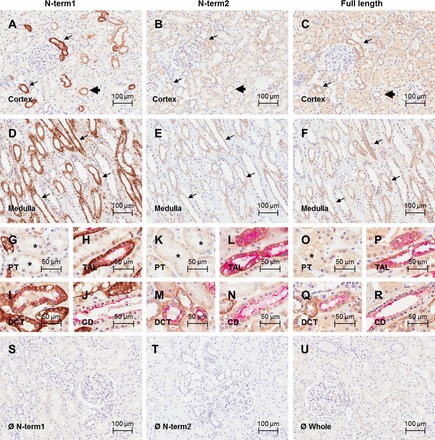Fig. 6.

CaSR immunolocalization in human kidney sections. Photomicrographs shown of human cortical kidney sections immunostained with the CaSR antibodies N-term1 (Thermo; A), N-term2 (Anaspec; B), and full length (Novus; C). Photomicrographs of human medullary kidney sections immunostained with the CaSR antibodies N-term1 (D), N-term2 (E), and full length (F). Positive CaSR signal corresponds to immunoperoxidase staining (brown), and nuclei are counterstained with hematoxylin (blue). Arrows indicate stronger signal consistent with TAL, and arrowheads indicate weaker signal consistent with DCT and CD. Photomicrographs show CaSR immunoreactivity in the PT, identified by the presence of brush border in kidney sections immunostained with N-term1 (G), N-term2 (K), and full length (O). Asterisk indicates the PT. Photomicrographs show CaSR immunoreactivity in the TAL, identified by dual staining with Tamm-Horsfall protein in kidney sections immunostained with N-term1 (H), N-term2 (L), and full length (P). Photomicrographs show CaSR immunoreactivity in the DCT, identified by dual staining with NCC in kidney sections immunostained with N-term1 (I), N-term2 (M), and full length (Q). Photomicrographs show CaSR immunoreactivity in the CD, identified by dual staining with AQP2 in kidney sections immunostained with N-term1 (J), N-term2 (N), and full length (R). Nephron segment marker signal corresponds to (red) fast red staining. Photomicrographs are also shown for the negative controls for N-term1 (S), N-term2 (T), and full length (U) performed by omitting the primary antibody. Scale bar = 100 μm for pictures in A–F and S–U and 50 μm for pictures G–R.
